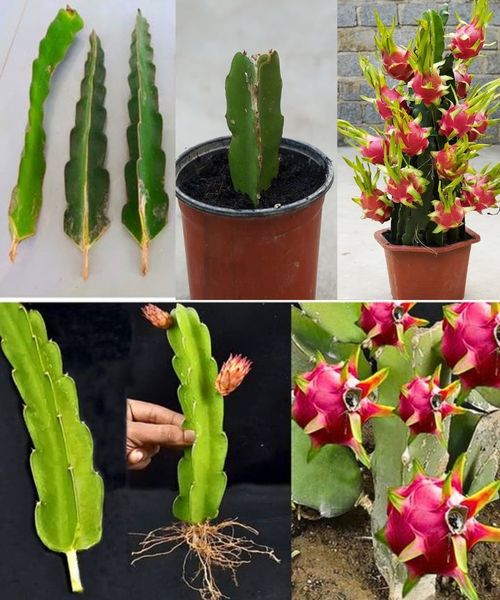Beginner’s Guide to Growing Purple Dragon Fruit from Cuttings
Dragon fruit, or pitaya, is a striking and exotic fruit that’s quite rewarding to grow, particularly the purple variety (Hylocereus costaricensis) with its vibrant magenta flesh. Starting from cuttings is an efficient way to propagate dragon fruit, and here’s a beginner-friendly guide to get you started.
Benefits of Growing Dragon Fruit from Cuttings
- Faster Growth: Cuttings typically establish more quickly than seeds, leading to faster fruit production.
- Genetic Consistency: Cuttings produce plants identical to the parent, ensuring consistent fruit quality.
- Ease of Propagation: Growing from cuttings is straightforward and requires minimal effort.
Materials Needed
- Healthy dragon fruit cutting
- Sharp, clean knife or pruning shears
- Rooting hormone (optional)
- Well-draining cactus or succulent potting mix
- Pot or container with drainage holes
- Watering can or spray bottle
- Support stakes or trellis
Step-by-Step Guide
1. Selecting and Preparing the Cutting
- Choose a Healthy Stem: Select a mature, healthy stem from a dragon fruit plant. The cutting should be at least 12 inches long and free from disease or damage.
- Cut the Stem: Use a clean, sharp knife or pruning shears to cut the stem at a 45-degree angle to increase the surface area for rooting.
- Dry the Cutting: Allow the cutting to dry and callous over for a few days to a week. This helps prevent rot when planted.
2. Optional: Applying Rooting Hormone
- Dip in Rooting Hormone: Optionally, dip the calloused end of the cutting into rooting hormone powder. This can help encourage faster root development, though cuttings often root successfully without it.
3. Planting the Cutting
- Prepare the Pot: Fill a pot or container with well-draining cactus or succulent potting mix. Ensure the pot has drainage holes.
- Plant the Cutting: Insert the calloused end of the cutting into the soil about 2-3 inches deep. Firmly press the soil around the base to stabilize the cutting.
4. Watering and Initial Care
- Water Lightly: Water the cutting lightly immediately after planting to moisten the soil.
- Provide Indirect Light: Place the pot in a bright, indirect light location. Avoid direct sunlight initially, as it can stress the cutting.
- Maintain Moisture: Keep the soil lightly moist but not waterlogged. Water when the top inch of soil feels dry to the touch.
5. Providing Support
- Support Structure: As the dragon fruit grows, it will need support. Use stakes or a trellis to support the growing plant.
- Secure the Plant: Tie the stem to the support structure with soft plant ties or twine, making sure it is secure but not constricted.
6. Ongoing Care
- Sunlight: Once the cutting is established and growing, gradually acclimate it to more direct sunlight. Dragon fruit thrives in full sun but can handle partial shade.
- Watering: Maintain regular watering, allowing the soil to dry out slightly between waterings. Avoid overwatering to prevent root rot.
- Fertilizing: Apply a balanced, slow-release fertilizer every 2-3 months during the growing season (spring and summer). Reduce fertilization during the dormant season (fall and winter).
7. Transplanting Outdoors
- Transplanting: Once the cutting has a strong root system and new growth, consider transplanting it outdoors.
- Choose a Location: Pick a sunny location with well-draining soil. Plant the cutting at the same depth as in the pot and provide support with a trellis or stakes.
8. Pest and Disease Management
- Inspect Regularly: Check for pests like mealybugs or aphids and treat infestations promptly with insecticidal soap or neem oil.
- Air Circulation: Ensure good air circulation around the plant to prevent fungal diseases. Avoid overhead watering to reduce the risk of rot.
9. Harvesting Dragon Fruit
- Harvest Time: Dragon fruit usually takes 6-9 months from planting to produce fruit. It’s ready to harvest when the skin turns a vibrant color and the scales begin to separate slightly.
- Cut the Fruit: Use a sharp knife to cut the fruit from the plant, leaving a small section of the stem attached.
Conclusion
Growing purple dragon fruit from cuttings is an enjoyable and straightforward process, ideal for beginners. By following these steps and providing proper care, you’ll soon be able to enjoy the exotic beauty and delicious taste of homegrown dragon fruit.

